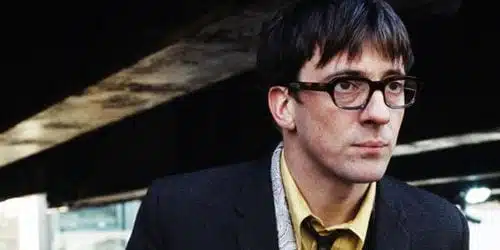
At the height of Blur’s fame during the Britpop ’90s, it fell to Graham Coxon to single-handedly maintain his group’s indie credibility. Contrasted with its archrival Oasis — Northern England-bred, working-class, rrrrrock with a rolled “r” — the middle-class Colchester natives that made up Blur were less gritty, more cerebral, and more pop, traits that at times made the group look stuffy and insincere in comparison. (It certainly didn’t help that singer Damon Albarn took to exalting the virtues of football in a condescendingly fake Cockney accent during the period). Through the reign of Cool Britannia, the bespectacled, boyish-looking Coxon stood as a reminder of Blur’s less tidy aspects, praising Pavement and smearing abrasive guitarwork indebted to formative years listening to Dinosaur Jr. and the Pixies around Albarn’s Kinks-style character studies whenever possible. The guitarist’s affection for noisy American alt-rock eventually made its mark on Blur (stadiums around the world will forever be thankful for “Song 2”), but he noticeably hasn’t overindulged his less commercial tastes in the solo efforts he’s released since leaving the group during the making of 2003’s Think Tank. Indeed, his post-Blur records seem to delight in offering up surprising detours like the fingerpicked folk of The Spinning Top (2009) and Happiness in Magazines (2004), an album generously stuffed with the sort of melodic and very British songcraft commonly assumed to be Albarn’s domain.
Coxon’s a much-admired guitarist (Oasis’ Noel Gallagher has even praised him as one of the most talented axemen of his generation), so you can bet there’s a lot of people out there eager to hear him plug in and just let it rip. Good news, then: if you crave Coxon’s music with the Amerindie lo-fi damage cranked up to 11, then A+E is for you. It’s the product of a quick ‘n’ dirty—first takes are abundant in the final product—two-month-long recording period with Think Tank producer Ben Hillier that yielded 22 tracks (most of the remainder that didn’t make this album may see release as a subsequent LP later in the year). Though Coxon plays virtually every instrument save a few synths, A+E emphasizes distorted guitar-driven rock like nobody’s business. It’s an about-face from its acoustic predecessor The Spinning Top, boasting ten tracks awash with skuzzy riffs, janky synths, and loads of errant noise captured by mics left intentionally open in the recording booth.
The music’s not as reckless as surface impressions would have listeners believe. The opening track “Advice” plays with expectations in its first few seconds, presenting Coxon fiddling about with his six-string, with little consideration for precise time-keeping. One well-placed drum beat later, he quits fooling around and launches into one of the single best riffs he’s ever written, a nagging, twisting figure that immediately lodges in the memory. Be it “What’ll It Take” or the bashing stomp of “Bah Singer”, it’s clear that recognizably pop song structures form the basis for almost every cut on A+E (the subdued “Knife in the Cast” is an entrancing departure from the norm that’s almost Young Marble Giants-esque in its stark, percussive minimalism). And given we’re talking about the man who helped make Parklife and The Great Escape, it’s no surprise that Coxon sure knows how to put solid pop songs together. There’s always a tunefulness to his indie skronk, and he has a masterful grasp of the intricacies of a great groove when he doesn’t deploy routine eighth-note strumming or opt for rinky-dink drum machine patterns. Even with the drum machine puttering on, a cut like “City Hall” is always commendably weighty and body-shaking, its massive bassline throb sounding positively huge.
With the exception of the concise “Advice” (the mind boggles that it wasn’t chosen as the lead single over the comparatively stiff “What’ll It Take”), the one nagging annoyance that consistently dogs A+E is song length. It’s frequent for tracks to root themselves into steady, propulsive rhythms that go from verse to chorus to verse and back again ad nausem until Coxon decides it’s time to wrap a number up — which is without exception several bars later than he should’ve done it. Coxon’s penchant for riding out grooves until he exhausts all ideas for leads and textures to lay over them prevents the rest of A+E from being as flat-out gripping its leadoff track, but the need to trim excess time off doesn’t undermine the cores of the scruffy rockers he has put together — they’re still pretty damn catchy, and should have listeners up on their feet with little effort. Fifteen years after Cool Britannia petered out, A+E is more than enough proof that Graham Coxon is still one of Britain’s coolest and most interesting rock guitarists. Now if only the reunited Blur will get to making a new studio album…

